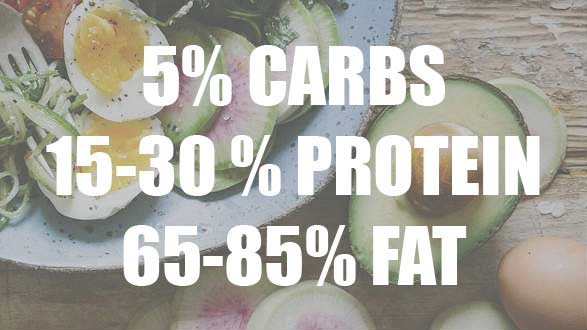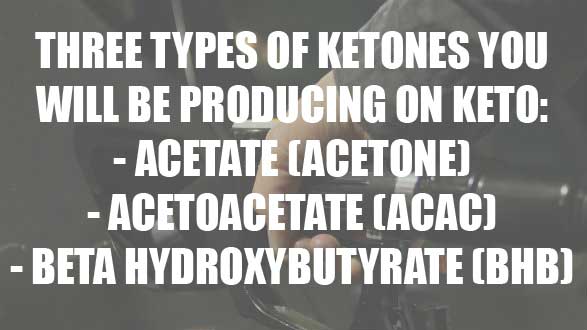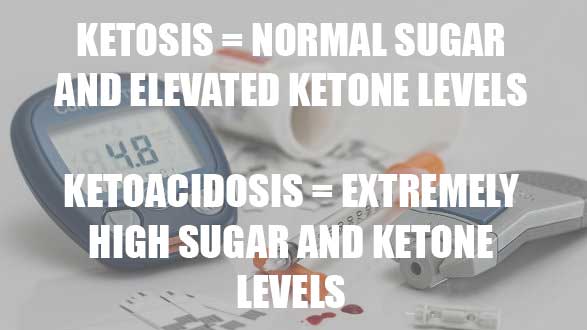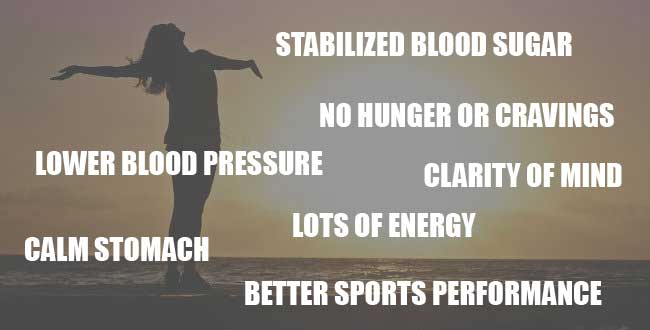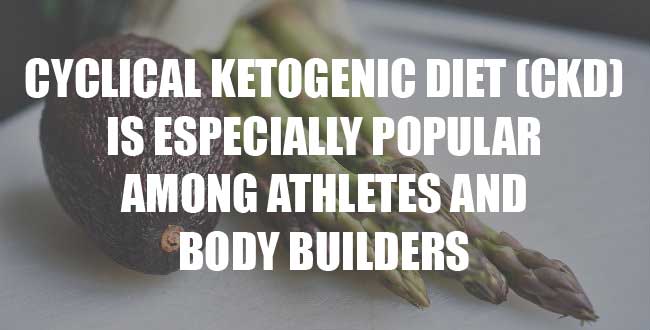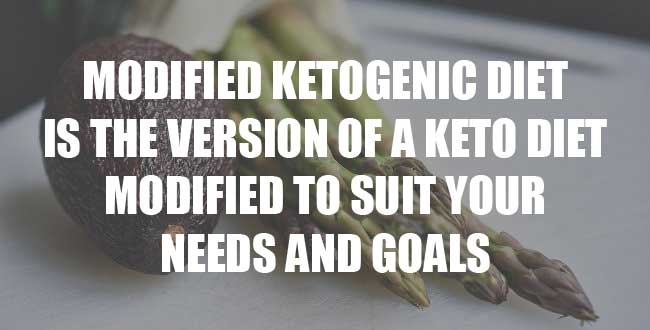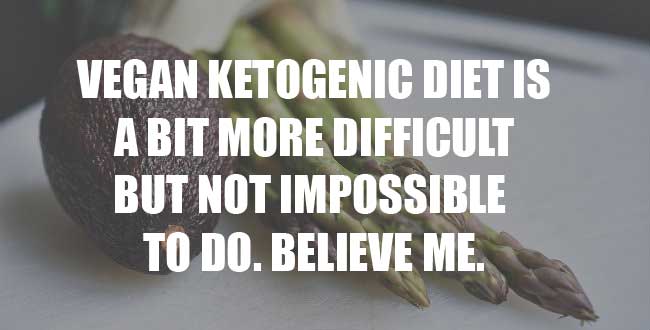Wondering what a keto diet it? Why is a ketogenic diet becoming so popular? What makes it different (and better) than other eating programs? In this section you will find all the necessary resources to give you a head start on a keto diet.
Keto diet is a no sugar diet as well, so I invite you to take a look at my other no sugar diet guide.
Introduction To A Keto Diet
The concept behind a ketogenic diet (or a keto diet) is very simple, but the impact this diet can have on your health, life and overall well-being may be really powerful.
A ketogenic diet is simply a stricter version of a low-carb diet in which you restrict eating carbohydrates, such as, pastas, bread, grains, starches and any food high in sugar. Instead, you eat a lot of vegetables, meat, fish, eggs and healthy fats like butter, nuts (including nut butters) or coconut oil. You can still drink your favorite coffee and tea as long as you don’t put sugar into it.
More and more research shows that a ketogenic diet has lots of health benefits and is one of the most effective weight loss tools. All you need to do to be successful with a keto diet is understand its basics and consistently follow a few simple rules.
This is exactly what we are talking about here on ABC Keto. Explore this section to learn the basics of a ketogenic diet and start transforming your life today. I’ll be your guide every step of the way.
Here is the index of the main topics covered in this section. Just click on the topic of your interest to jump straight to it or read the whole guide from cover to cover (highly recommended).
Keto Diet Basics
Learn the basics of a ketogenic diet so that you can have a head
start in your keto journey. Learn what a ketogenic diet really
is, how to start it and how to do it right. Read about the most
common keto diet concerns and topics, such as, a keto diet for
women or using this eating plan for effective weight loss.
Ketosis Basics
Learn the facts and benefits of being in the state of ketosis
and why you should put your body into it. Discover how you can check
if you are in ketosis, what common symptoms of ketosis are and
how to get back into ketosis if you (accidentally) get off track.
Discover how long you should stay in ketosis for maximum benefits.
Keto Diet Types
A ketogenic diet comes in a few different variations and each one
has its pros and cons. Learn about different types of ketogenic
diets and choose the one that suits your goals and needs the most.
Keto diet types discussed here include cyclical, targeted, modified,
vegetarian and vegan variations, among others.
Pros & Cons
A ketogenic diet has so many health, mental and fitness benefits
that it’s sometimes even difficult to list them all and not forget
about one or more of them. But even so, a keto diet still has some
drawbacks and doing it may be risky for some people. Learn about
its pros & cons as well as possible risks to stay on the safe side.
Keto Diet Rules
A keto diet is very easy to follow and very effective as long as you
are aware of all its rules and abide by them. In this section you will
learn more about your ideal macros for keto, foods you should eat,
foods you absolutely have to avoid and necessary supplements.
Bonus topic includes cheating and its bad (and good) effects.
Common Mistakes
If you are new to a ketogenic diet, you are much more likely to
commit one or more of the top ketogenic diet mistakes. This can
completely nullify your progress, stop weight loss and kick you
out of ketosis. In this section you will learn about the most
common ketogenic diet mistakes and how to avoid making them.
Example Keto Meals
A correctly formulated keto diet is, after all, about eating the
right types of foods and avoiding the forbidden ones. Fortunately,
a keto diet allows you to eat tons of delicious meals and desserts.
Take a look at example ketogenic diet meals, such as, breakfast,
lunch, dinner, desserts and the most delicious coffee on earth.
Research & Resources
More and more research on a keto diet is done every day by lots of
doctors, dietitians, scientists and researchers. New and awesome
properties of this eating program come to light each and every day.
This section reviews the newest and especially important research
findings relating to a ketogenic diet, its properties and effects.
Keto Diet Basics… To Get You A Head Start
If you are only beginning your keto journey, make sure to study the whole keto diet secion of ABC Keto. You will find all the necessary facts, information and tips as well as links to more in-depth and detailed tutorials (including to external sources I find especially interesting).
Let’s start from the basics of what a keto diet and the state of ketosis are.
What Is A Keto Diet?
A ketogenic diet is a high-fat, low-carb and moderate-protein diet initially used to treat epilepsy among children in 1920s.
It turns out, however, that a keto diet has way more benefits than just being a cure for epilepsy.
Not only is it ideal for optimum health or sports performance, but it is also one of the most effective fat-burning tools.
On a ketogenic diet you:
- eat less than 20-30 grams of carbohydrates a day (5-10% of your daily calories)
- eat a moderate amount of protein (15-30% of your daily calories come from protein)
- eat a lot of fat (65-80% of your calories come from fat)
One of the main keto principles is to eat real foods and avoid any processed foods which are usually full of hidden carbs and sugar.
Most people following a ketogenic diet can eat as much delicious keto-friendly foods as they want and still lose pounds. That’s because keto foods are not only super delicious but also highly nutritious and satiating.
If you restrict carbohydrates and eat a lot of fat, the chances are you will not be able to eat more calories than your body needs. You will feel satisfied much earlier and almost naturally lose weight.
Of course, it is possible to burn fat and lose weight without being in ketosis. However, ketosis is the most optimal and effective fat-burning mode our body can enter into. This is a sort of metabolic revolution that you can induce in your body. Why not take advantage of it?
Why A Keto Diet Instead Of Some Other Popular Eating Plan
There are just countless reasons why a ketogenic diet will be the best choice for you. It doesn’t matter if it’s the first time you are changing you eating habits or if you’ve already tried one hundred other eating plans and have “broken” metabolism. What matters is that you have come to the right place and discovered the right eating plan. That is the keto diet.
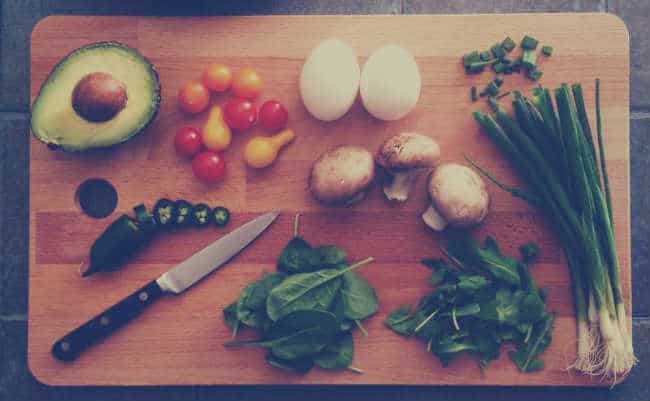
Congratulations. The ketogenic diet is the best choice.
Here are a few (out of probably hundreds) reasons why you should choose a keto diet instead of some other currently popular diets (or simply fads):
- WORKS DEEP WITHIN. It changes the way your metabolism works (you switch to fat-burning from running on sugar), which means improvements in your body at a cellular level. Whether you are doing keto to lose weight or to improve your health, you will be curing the causes (not effects).
- HORMONAL REGULATION. It regulates hormones responsible for fat storing, fat burning and you feeling hungry or satisfied, among other things. A keto diet is the only diet on which you won’t be hungry all the time. It’s hormones that either make you hungry or satisfied and keto takes a good care of that.
- WORKS LONG-TERM. One of the biggest advantages of a keto diet is that it works in the long-term and lets you lose weight or cure some health conditions once and for all. People who lose weight with keto usually stick with this plan for many years and never regain the weight they had lost thanks to it.
- IT’S BUDGET-FRIENDLY. Most of the everyday meals you will be eating on a keto diet are very simple to prepare and quite cheap. Since a keto diet naturally suppresses your appetite, you will naturally eat less often and eat smaller portions. You will see much more money left in the pocket and that won’t make you hungry (or “hangry”). Awesome!
- IT IMPROVES YOUR HEALTH. Not only do most diets usually end up with the yo-yo effect but they usually starve you and worsen your health. That’s not the case with a keto diet! Every product and every meal you consume on a keto diet provides nutrition for you. Even if you aren’t doing keto for health purposes, you will see huge improvements as early as after a few weeks. Miracle diet? I guess.
I hope these five simple reasons convinced you that a keto diet is the way to go and you are ready to continue reading. You may also want to check a very inspirational website about keto diet and low-carb diets.
What You Can Eat On A Keto Diet (In A Huge Nutshell)
You will find tons of visual guides, articles, posts and recipes which will make your keto diet journey delicious and almost effortless here on ABC Keto. This is a quick round-up of what you will be eating on keto:
- Lots of natural and healthy fats, such as, butter, coconut oil, heavy whipping cream, olive oil, lard, nut butters and more.
- Healthy sources of protein like eggs, fatty meat, fatty fish, cheese and more.
- A lot of both fresh and fermented low-carb vegetables like avocado, cucumber, spinach, salad, arugula, asparagus, broccoli, pepper, sauerkraut and more.
- Small portions of low-carb fruits like strawberries, blueberries, raspberries or grapefruits.
These are, of course, a few examples of delicious foods you can consume on a keto diet. Basically, you can eat anything as long as it’s not processed (it’s real food) and doesn’t have carbs (or has only a few of them).
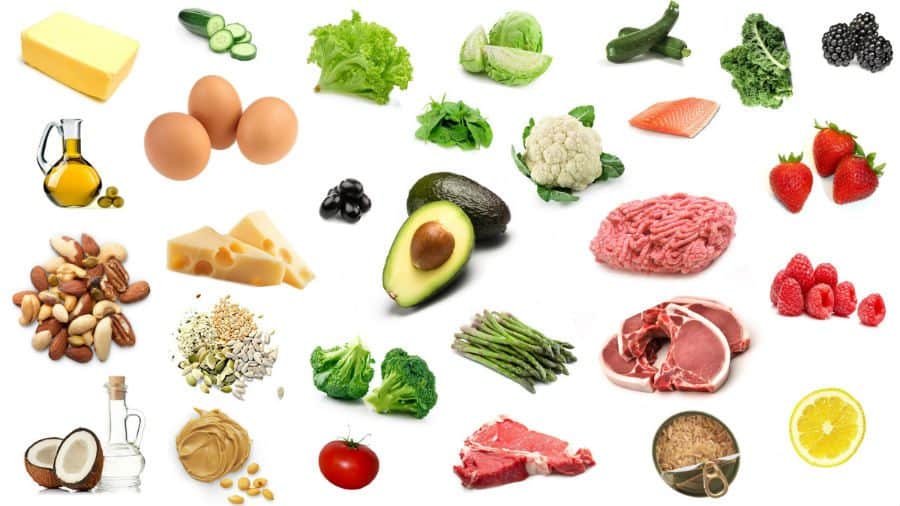
These are example foods to eat on a keto diet.
If you want to learn more about what you will be eating on this delicious program, check the keto diet recipes and the keto diet foods (two extensive sections).
How To Start A Keto Diet (Just Do It)
Once you have ABC Keto at hand, you are ready to start your keto journey and do it right from day one. The sooner you start, the better for you. You don’t need to spend hours calculating your macros or calories at this point. We will get to than later in more detailed and in-depth tutorials. All you need to do know is simply start. The following tips will help you do that.

The best thing you can do right now is decide and start a keto diet.
Here is what you need to do to start a keto diet:
- Make a decision to start a keto diet TODAY. The latest possible deadline I can give you is TOMORROW. Choose to go keto either right at this moment or tomorrow morning.
- Eliminate all the forbidden products from your diet and if possible remove them from your home as well. Give them to your non-keto friends or simply throw them away. Start from eliminating the worst, i.e. sugar, starches, rice, pasta, sweets, cereals, crackers, biscuits, candy, bread, buns or any processed foods (like fast foods). Trash high-sugar fruits like bananas or apples as well.
- Start eating good fats and protein with each meal. Add butter or coconut oil to your coffee. Begin to love the taste of nut butters. You are perfectly OK eating fat as long as you don’t combine it with carbs.
- Replace sugar with some natural sweetener if you cannot give up the sweet taste at this point. The best sugar replacement is either stevia or erythritol.
- Start preparing keto meals (especially keto desserts) for yourself and your family.
- Eat only when you are hungry and stop when you feel satisfied. Make sure not to eat out of boredom or simply habit. Listen to your body. It perfectly knows what it needs.
- Come back to ABC Keto often to learn more and stay on track.
My purpose is to give you as many great keto diet resources as possible so I am sharing another of my favorite ketogenic diet guides (blogs) here.
Is Keto Safe? Is Keto Healthy? Two Common Concerns
Everyone who learns about a keto diet and starts considering it will, sooner or later, ask if it’s safe and healthy. Is eating so much fat really healthy? Won’t I put my body into the starvation mode once I achieve ketosis? I know I may be repeating myself but I need to tell you the same thing yet one more time: keto is both healthy and safe.
One of the goals of ABC Keto is to convince you that a keto diet is totally safe, healthy and will change your life for the better. All you need to do is make sure you are not in the risk group (pregnant, breastfeeding, suffering from diabetes or on prescribed medication) and you are good to go.

A keto diet is both safe and healthy. All you need to do is just make sure you are not in the risk group (you probably aren’t).
Unfortunately, many people give up on a keto diet after a few days when the first symptoms of a keto flu begin to appear. Before you do that, you must know that feeling a bit worse in the transition period is perfectly normal and natural. The bigger sugar addict you are, the worse your keto flu will be and that’s OK.
So What Is The Keto Flu? An Inevitable Question & True Answer
The (sad) truth is that 99% of people run on sugar as their main source of fuel. That’s why usually 99% of people going on a ketogenic diet experience the keto flu symptoms. For some people the symptoms are hardly noticeable while others feel like they were about to die. This is very individual and context-specific.
What you need to know at this point is that the keto flu is a perfectly normal reaction of your body and you don’t need to worry about it. Just be patient and it will go away. Once it goes away, it will probably never come back (at least not in this initial more severe form), because you become keto-adapted for the rest of your life.

Once the keto flu is gone, you will have the new (and better) machinery to burn fat in your body.
Here are a few basic facts about the keto flu you need to know about:
- It usually lasts from a few days up to a few weeks (in some extreme cases).
- In most cases its main symptoms are migraine-like headaches, lack of strength or feeling nauseous.
- This is the transition period during which you are building new machinery. You need new machinery because you’ve been running on sugar your whole life. Be strong and patient.
- Once it’s over, you will feel better than ever. The time of your life will begin.
Check the full keto flu guide to learn more about it and how to effectively deal with the adaptation period. Here is also a nice guide on how to remedy the keto flu.
Keto Diet And Women (Read This If You Are A Woman)
Together with a growing popularity of a keto diet, the topic of women doing a keto diet (and intermittent fasting) has also become very popular on different forums and Facebook groups. I am a woman who has been doing both keto and intermittent fasting (click to learn more) for more than half a year now and I absolutely LOVE them both.
However, I would have started a bit differently if I had known what I know now. You can still do it right and avoid any negative and women-specific consequences.

A keto diet is a perfect choice for women but they must be a bit more careful with it than men.
Women can (and should) do a keto diet to achieve their health, fitness or weight loss goals. My best recommendation is not to begin very aggressively (like I did) but rather step by step. It’s best to implement small changes in your diet on a weekly or even monthly basis instead of making a huge revolution in one day (and putting enormous stress on you system).
If you want to lose weight, give yourself a bit more time to achieve your weight goal so that weight loss happens naturally together with your body adjusting to burning fat for fuel. The state of ketosis is a form of a “starvation” signal sent to your body and if you go overboard at some point, this change can mess with your female hormones.
Don’t worry, though. The good news is that you have me to guide you every step of your keto journey so that you don’t make the mistakes I made and achieve the results you are dreaming about.
If you are a woman, make sure to read the full guide to keto for women where I will tell you how to do this program step by step so that you don’t get any negative effects or at least minimize their risk.
Keto Diet And Weight Loss (Read This If You Want To Lose Weight)
A keto diet is the most effective and the best weight loss tool on earth. That’s because it changes the way your body works and uses fat. Instead of running on sugar, you will be running on fat and will become extremely efficient at burning your own body fat.
If you combine a ketogenic diet it with intermittent fasting (click to view the whole guide), you will be amazed at how quickly you will be burning fat and losing weight.

If weight loss is your goal, you have chosen the best possible plan to help you do that.
Once you get into ketosis, you will not feel hunger and all your carb cravings will naturally disappear. A keto diet is probably the only diet or eating plan on which you almost effortlessly turn into a fat-burning machine. How cool is that?
If weight loss is one of your goals, you cannot miss the keto weight loss section of this website. This is the most comprehensive guide to losing weight on a keto diet on the entire internet.
Ketosis Basics… Getting Into Science
The name of a keto diet comes from the metabolic state of ketosis which you achieve once you restrict eating carbohydrates. If you do a ketogenic diet (and don’t commit any of the fatal mistakes), you will enter ketosis usually within a few days. That’s when hundreds of favorable process will be triggered and you will start to notice lots of positive changes.

Let’s get into the science of ketosis, ketones and how it all works.
Let’s get into the science of ketosis so that you better understand what will be happening in your body once you switch to a keto diet. Ready to start?
What Is Ketosis?
Let’s break this fascinating topic down a little bit, so that you understand what ketosis is (click to read the Wikipedia article) and why you might want to consider putting your body into this favorable state.
Many doctors or keto experts like to explain ketosis in overly complicated and medical terms. There is no need to do that because ketosis is not rocket science and for most people it’s enough to know just a few simple facts I am about to share. Here is all you need to know.
Our body needs energy to live and there are two sources of energy it can use:
- glucose (the “default” and easily-available source)
- fat (the “alternative” or reserve energy source)
Ketosis is a metabolic state in which our body uses fat as an energy source instead of the default glucose. In the state of ketosis our liver converts fat into ketone bodies and fatty acids to fuel our body and brain.

This is how ketosis works in a nutshell.
Ketosis can be induced only in the absence of carbohydrates because carbs are the easiest and preferred source of energy for our bodies. Without glucose, our body has no other choice than to use the reserve tank, i.e. fat.
Ketosis is a natural survival mechanism which is initiated when the intake of food (or, in our case, carbohydrates) is low and the body “thinks” starvation is coming. We are, of course, not starving ourselves on a ketogenic diet, so here is an important distinction to make:
- Nutritional ketosis is the state in which your body switches to fat-burning due to the absence of carbohydrates. Lots of positive changes and processes are happening when you are in nutritional ketosis. This is healthy and this is what we are aiming for.
- Starvation ketosis happens after a few weeks of no food intake when your body starts to shut down its mechanisms and basically begins to hibernate. This is not good and we aren’t getting anywhere near.
In the fat-vs-glucose game, there is also the third player called insulin. This is the hormone that spikes any time we eat carbohydrates so that our body can handle elevated levels of glucose in our blood and convert it into fuel.
In the presence of insulin, unfortunately, there is no fat burning. That is why insulin is often called the fat-storing hormone. The less carbohydrates we eat, the less insulin we spike and the more fat we can burn. You may be surprised to hear that eating more fat does not equal storing more fat. It’s the opposite (of course, within reason).
Only by eating more fat and less carbs can you burn a lot of your own body fat. Sounds crazy but it’s true. That’s why if one of your main goals is to lose weight, you might want to put our body into the most optimal state of fat burning, i.e. ketosis.
Learn more about what ketosis is and how it works in the special ABC Keto guide to ketosis. I also recommend reading the article of Dr. Jason Fung on insulin and its effect on fat storage. If you are already familiar with the topic, read my guide of how to get into ketosis.
What Are Ketones?
The name of a keto diet and the state of ketosis comes from ketones (or simply ketone bodies) that run in our system once we get into the state of ketosis. This whole keto “fuss” is all about ketones, after all. Contrary to what you may think, they are nothing new for our body which perfectly knows how to use them and what they are for.
Here are a few simple facts you need to know about ketones to understand the role and purpose of a keto diet:
- Ketones are produced in our body (by the mitochondria of the liver) once it runs out of sugar and switches to the alternative energy source, i.e. fat.
- Ketones are the result of our body using and converting fat for energy. They are good!
- There are three types of ketones: acetate (acetone), acetoacetate (AcAc) and beta hydroxybutyrate (BHB).
- There are three major ways of measuring ketone levels: in the urine, in the blood and and in the breath. The blood test is considered the most reliable but is also the most expensive one.
- The most optimal ketone level range is between 1.0 and 3.0 mmol/L. But it’s still OK to have lower levels and lose weight.
- Ketone bodies are your friend and using them as a fuel source gives you tons of benefits (basically the whole ABC Keto is about this).
Learn more about what ketones are and how to measure them in the special ABC Keto guide to ketones. Or check the article about ketones on Wikipedia.
Ketosis Vs Ketoacidosis (Important Distinction To Make)
Many ignorant people confuse ketosis (a totally safe and beneficial state) with the life-threatening ketoacidosis. Nutritional ketosis (when your ketone levels are elevated but glucose levels are within the normal range) has nothing to do with ketoacidosis in which both the level of glucose and blood ketones are extremely high.
This is the problem that may occur practically only in diabetic people who are unable to product insulin to lower blood sugar. This happens extremely rarely and unless you are a type-1 diabetic, you have nothing to worry about.
Nevertheless, I always recommend consulting your doctor before embarking on any new dieting style and that’s what you should do in this case too. Here is a more detailed article explaining diabetic ketoacidosis.
How To Get Into Ketosis (The Right And The Quick Way)
Of course, it’s possible to burn fat and be relatively healthy without being in the state of ketosis. However, if you want to achieve the best possible results (and reap a bunch of “extra” health benefits), it’s recommended that you enter ketosis.

Water fasting (drinking only water) is one of the quickest ways to get into ketosis.
There are basically three ways of how you can get into ketosis:
- Stop eating for a couple of days (not recommended for people without any experience with fasting and intermittent fasting). Fasting is a proven and the quickest method of inducing ketosis.
- Reduce your daily intake of carbohydrates to below 20 grams and you will be in ketosis within a few days (up to a few weeks in some cases). Just make sure not to eat any hidden carbs.
- Increase the intensity and length of your workouts (together with restricting the amount of carbs) and/or work out in a fasted state. Nothing speeds up the process as well as intense exercise.
If you are new to the ketogenic diet, you will quickly start to feel the symptoms of carb and sugar withdrawal commonly known as the keto flu. Remember that you need to be patient. The keto flu will go away and the best time of your life will begin.
Learn all the necessary information on how to get into ketosis in the special guide I have prepared for you.
How Do I Know If I Am In Ketosis? What Does Ketosis Feel Like?
There are a few methods which let you check if your body is in ketosis. You can use urine strips, blood ketone tester or a breathalyzer (a relatively new method) or simply watch for characteristic ketosis symptoms.
In the beginning of your keto journey, you may want to check your ketone levels to make sure you aren’t committing any of the most common keto mistakes. However, once you become more “keto-proficient” you will know when you are in ketosis and when you got kicked out.

After you become keto-adapted, you will simply know when you are in ketosis. You will feel super cool.
Make sure to read the full guide on how to tell if you are in ketosis without testing ketone levels. Here is a nice guide on how to test ketone levels.
Most Common Symptoms Of Ketosis (Almost Everyone Gets)
Early symptoms of ketosis are often not very friendly and that’s why they are commonly called the keto flu. Fortunately, the keto flu usually lasts not more than a week after which you discover that being in ketosis really feels like haven. Here are the most common long-term and short-term symptoms of ketosis:
- Great clarity of mind and alertness (no afternoon crash or need to drink tons of coffee throughout the whole day)
- High and steady level of energy throughout the day (from the moment you get up to the moment you fall asleep)
- No hunger and cravings for sweets or carbs (the food you will be eating will fully satisfy you)
- Increased sports performance (even in the case of endurance athletes)
- Lower blood pressure and lower pulse rate (which simply means longer life)
- Regulated blood sugar (and saying goodbye to diabetes)
- Great mood (you will wake up happy every morning)
- No bloating or water retention (your stomach will be calm and quiet)
Got inspired by these few symptoms of ketosis? Read the full article to learn more details, facts and discover even more symptoms of being in ketosis.
What Is Ketosis Flu? Is This The Same As Keto Flu?
Yes, the ketosis flu is the same term even though the keto flu term is more common. For the reminder, this is simply the transition period during which your body is learning to run on fat instead of sugar (on which it has probably been running your whole life).

Ketosis flu is basically the same as keto flu. You can use both terms interchangeably.
The ketosis or keto flu may be a bit bumpy and hard but once it’s gone you literally have a new life.
Not sure if you are experimenting the keto flu? Check the full list of keto flu symptoms and how to deal with them.
How To Get Back Into Ketosis (Cheat Meal Fans, Attention Please)
A keto diet is one of the stricter diets as it doesn’t really let you get off track too often. That’s because it usually takes a few days before you get into ketosis (and optimal fat burning) and any deviation (like eating sweets or more than 30 g of carbs) usually kicks you out of ketosis.
Depending on how active you are, your age and metabolic rate, it make take anywhere from several hours up to several days to come back to the most optimal level of ketones (1.0 – 3.0 mmol/L). If you want to heavily binge every weekend, the chances are you will never really enter the optimal level of ketosis which is sometimes achieved only after a few weeks of doing keto without any deviation.
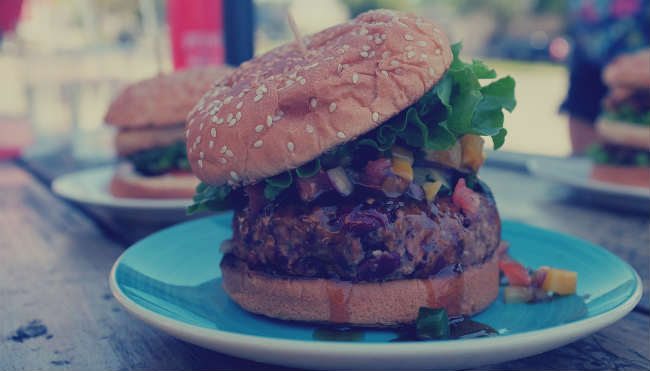
Cheating too often or too heavily may entirely prevent you from reaching the most optimal ketosis.
However, we all know that cheat meals (and sometimes even cheat days) are necessary and they have both pros and cons. Not only do they let you restore glycogen reserves but they also give you a metabolic boost. The key is to use “the cheating tool” intelligently and know how to get back into ketosis as quickly as possible.
Here are the top three tips that will let you get back on track more quickly:
- Do a longer (24 or even 36-hour) fast straight after the cheat day. After eating tons of bad foods and carbs on your cheat day it will be much easier for you to fast than on a regular day during your daily keto routine.
- Make sure to do an intense workout first thing in the morning after your cheat meal. This will significantly speed up the whole process of getting back into ketosis.
- Don’t get frustrated. Instead, act as it never happened. Remorse won’t help you turn back time. Just come back to your keto routine and try to do keto for as many days in a row as you will be able.
Note that if you are an athlete who works out a lot, it’s totally OK to do carb-ups once a week or once every two weeks. Use common sense and don’t get frustrated too easily.
Got kicked out of ketosis? Don’t worry. Check the full guide on how to get back into ketosis after getting off track. Here is a wonderful guide to cheating on a keto diet.
When To Test For Ketones? And Whether You Need To Do This
There is absolutely no need for you to check your ketone levels every day or a couple of times a day. Their level will vary depending on what you eat, time of the day and your activity level. There are really many variables at play.
I personally know a lot of people doing a ketogenic diet who almost never check their ketone levels. They simply don’t need to do this as long as their (fitness, health or weight loss) goals are met. I advise you to do the same.
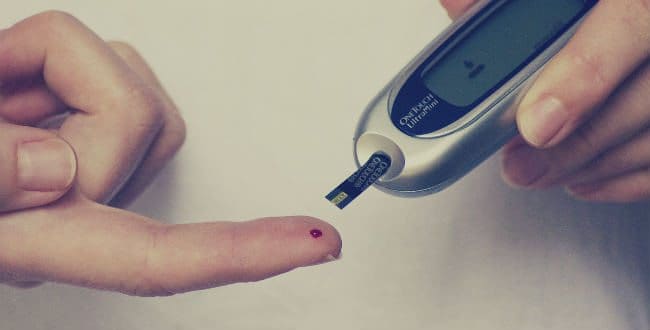
You may want to test for ketones at the beginning of you keto journey to make sure you are going in the right direction.
Here is the most common-sense approach to testing ketone levels:
- Do a ketogenic diet for a couple of weeks (6-8 weeks) straight, go through the transition period so that you feel OK again and then check where you are in terms of ketone levels.
- Choose one of you ideal keto days (when you do everything “by the book”) and check ketone levels three times (in the morning just after you wake up, after the last meal and after the workout) to see how they fluctuate.
- I recommend only checking ketone levels in blood (the levels of BHB). This is a bit more expensive but a fully reliable method.
Ketosis Supplements (If You Want To Boost Your Ketone Level Quickly)
There are lots of different ketosis supplements that promise to help you get into ketosis or get back to it even in a few hours. Most of these ketosis supplements are simply exogenous ketones (more about them in the further section and in the special guide linked below).
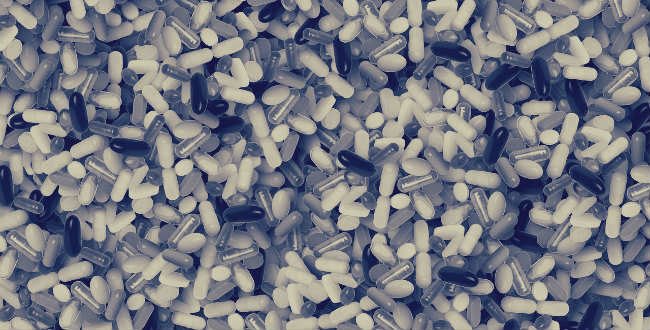
Exogenous ketones may help you in some situations but it’s best to rely on your own (endogenous) ketones.
You need to decide for yourself if you really need them. My common-sense piece of advice on ketosis supplements is:
- You may want to take ketosis supplements the next day in the morning after a heavy binge, but you shouldn’t really expect any miraculous effects. If you kicked yourself out of ketosis, you still need to naturally come back to it (and make your liver produce ketone bodies again).
- If you supplement ketones “from the outside” (that’s what exogenous ketones do), you will simply elevate their levels for some limited time. If you are keto-adapted and efficiently run on fat, you may feel a bit better and have better sports performance (if you take them before your workout). However, remember that it’s only a temporary solution and you need to deplete your glycogen stores to come back to producing “your own” ketones.
Not sure if you should take any ketosis supplements? Check my thorough review of the most popular ketosis supplements and the reasons to use/not to use them.
Exogenous Ketones & What You Need To Know About Them
Exogenous ketones have become very popular since their introduction in 2014. As their name “exogenous” suggests, they are simply ketone bodies that come from the outside of your body rather than from the inside (your liver). The ketones that are produced as a result of nutritional ketosis are, on the other hand, called endogenous.

It’s ultimately your choice if you want to drink exogenous ketones or not.
Supplementing exogenous ketone bodies lets you elevate your BHB level for several hours. This can have great impact on your sports performance and cognitive function if you need to boost them quickly and temporarily. Some people use exogenous ketones believing that they can get into (or get back to) ketosis faster. This may help a little but but I wouldn’t expect any miracles.
Keep in mind that exogenous ketones are only a supplement which you may or may not take. What you should focus on the most is doing the ketogenic diet without getting off track for as long as possible and acceptable for you.
Still a bit confused? Read my ultimate guide to exogenous ketones with more facts and tips on using exogenous ketones. Or check this nice guide to using exogenous ketones for weight loss.
How Long To Stay In Ketosis (It’s Not What You Think)
There are really tons of different theories on how long you should stay in ketosis and how long is too long. Many people claim that you can use a keto diet as a tool for several weeks and then you should come back to your “normal” eating habits. Others say a ketogenic diet should be your lifetime change and you can stay in ketosis for as long as you want (even your whole life).

There isn’t a time limit on how long you can stay in ketosis. It’s totally up to you.
So who is right? Where does the truth lie? As always, it’s somewhere in the middle. I think it’s best to look at this issue from the standpoint of our ancestors who (during winter) were in ketosis for many weeks (or months) in a row and naturally got out of it when fruits became easily available in summer months.
Here is what I suggest based on my own and other people’s experiences regarding how long you can stay in ketosis:
- You can certainly adopt a keto diet as a lifestyle (not a temporary fad which you will forget about in a few months).
- You can stay in ketosis for weeks and months at a time (if you feel like doing it).
- It’s a good idea to occasionally go out of ketosis and refill your glycogen stores (especially if you are an athlete).
- Using ketone bodies for energy in the long run promotes health and longevity (there are more and more studies that back it up).
As you can see, there isn’t just one best and the correct answer. It’s ultimately your job to find out how long you want to be doing this “keto thing” and how well this lifestyle aligns with your goals. I am here to help you find this out.
Types Of Ketogenic Diets… Six Most Popular Keto Diet Variations You Must Know (Plus Two Distinctions)
There are five main types of a ketogenic diet you should know about. Which type will be the most optimal for you depends on your goals, wants, needs and individual predispositions. You are free to experiment with all five types and choose the one that suits you the most.

Feel free to experiment with different types of ketogenic diets to find the one that suits you the most.
#1: Standard Ketogenic Diet (SKD)
A standard ketogenic diet is the most popular version of a ketogenic diet. Whenever you hear someone talk about a keto diet, the chances are they are talking about a standard ketogenic diet. SKD assumes that you eat below 20-30 grams of carbohydrates a day so that you can enter the state of ketosis.
20-30 grams of carbohydrates a day is the most often recommendation to induce ketosis. Some people (especially healthy athletes) have higher carb tolerance while others (especially those with insulin resistance) need to always stay below 20 g per day. Keep in mind that this amount may also vary depending on variables, such as, your age, sex, weight, height, metabolic rate and more.
#2 Cyclical Ketogenic Diet (CKD)
The cyclical ketogenic diet is the keto diet variation mostly aimed at athletes who want to get long-term benefits of being in ketosis and, at the same time, need peak sports performance.
The idea is that you want to refill your glycogen before an important competition (e.g. a marathon) or a very intense workout. Since you are already keto-adapted, it will be easy for you to switch to fat-burning once your body runs out of glucose and glycogen during intensive exercise. This will result in improved performance, a steady energy flow and overall better results (especially in endurance sports).
Interested in CKD? Check the full guide to the cyclical ketogenic diet with more examples, tips and guidelines. I am an athlete myself so I really know what I am taking about.
#3 Targeted Ketogenic Diet (TKD)
The targeted ketogenic diet will be most useful for athletes who are beginning their ketogenic journey and want to reap some of the benefits of ketosis and have top sports performance most of the time (especially body builders and strength athletes).
TKD seems to be the best solution for strength athletes and bodybuilders or people who for some reason cannot follow a standard or cyclical ketogenic diet. More and more research shows that endurance athletes (marathoners, for example) can sustain peak performance without doing carb refills (only following a SKD).
Interested in TKD? Check the full guide to the targeted ketogenic diet with more examples, tips and guidelines. I am an athlete myself and I tried different variations of a keto diet to find the most optimal one for me.
#4 Modified Ketogenic Diet (MKD)
As the name implies, a modified ketogenic diet is the version of a keto diet that allows for some modifications and adjustments so that it better suits your context and your specific needs. The general assumption of the diet (that you get most of your energy from fat) remains unchanged but you can be a bit more flexible with other macro-nutrients.
Basically, any version of a keto diet that has been changed a little bit in comparison to its original therapeutic version (to cure epilepsy in children) is a modified ketogenic diet. The example modifications may include:
- Eating a bit more protein on your workout days (30% of total calories or more).
- Eating more carbs (more than 20-30 grams per day) if you have higher carb tolerance (most athletes do).
- Eating (in small amounts) some of the forbidden products like some fruit (apples or bananas) or rice.
Modifying a ketogenic diet gives you a bit more food choices and freedom and, at the same time, lets you reap most of the benefits this eating style offers. If you do it right, you will be able to kill two birds with one stone.
#5 Vegetarian Ketogenic Diet
Even though a ketogenic diet is a bit strict when it comes to carbs, there are still so many food choices that vegetarians have no problems doing a keto diet. Even though I am not a vegetarian, I rarely eat meat (usually only two or three times a week) and I cannot say that my dishes are in any way limited or mundane. My meals are varied, nutritious and delicious.
Here are the top keto meat replacements (best sources of good protein and fat) for people interested in doing the vegetarian ketogenic diet:
- Tofu which you can make taste better than the best meat in the world
- Fatty fish like salmon or smoked mackerel
- All sea foods
- Nut butters, nuts and seeds
- Eggs which you can eat in almost unlimited amounts
Are you a vegetarian? Take a look at the vegetarian ketogenic diet guide with more tips, example meat replacements and a visual guide.
#6 Vegan Ketogenic Diet
If you are vegan, all you eat must be plant-based and cannot come from animals. This makes things a bit more difficult for vegans wanting to do a keto diet but it’s not impossible. You simply need to spend some time looking for and tasting the alternatives to the most common foods on a keto diet.
In most cases this is a one-time process and if you make sure to take all the necessary supplements, you will be good to go. Here are the top products and food people on a vegan ketogenic diet can eat:
- Tofu
- Vegan cheeses and sausages
- Hummus
- Nuts, seeds, nut butters
All you need to do is make sure that there is no added sugar in these vegan food replacements. Vegan products usually tend to have much more carbs (especially the hidden ones), so be aware of that.
Are you vegan? Take a look at the vegan ketogenic diet guide with more tips, animal product replacements and the visual cheat-sheet I’ve prepared for you. Here is a nice guide to the vegan keto diet.
Don’t Confuse Keto With… Because It’s Not The Same
A ketogenic diet is often confused with either the Paleo or the Atkins diet. There are some overlapping elements in all three diets but at the core they are different. Read the below short descriptions of both diets to better understand the differences between them and a keto diet.
Paleo
Both the Paelo and keto diet can have lots of great health benefits and can lead to serious weight loss. However, there are some crucial differences you need to be aware of:
- The Paleo diet is simply about eating quality and real foods while eliminating the ones that are heavy on your digestive system. On the Paleo diet you usually eliminate legumes, grains and diary. However, you don’t have to limit the daily amount of carbs, so you are free to eat most fruits and vegetables (including the ones forbidden on keto).
- The keto diet is stricter when it comes to eliminating carbs while on the Paleo program you don’t have to restrict carbs. That’s why people doing the Paleo diet will probably never induce ketosis and be able to run on fat as the main source of fuel.

On a Paleo diet you don’t need to restrict carbs and you usually don’t enter ketosis.
Although there are a lot of similarities and overlapping elements of both the Paleo and keto diet, you must know that they are not the same and usually serve different purposes. The Paleo is rather a healthy and nature-oriented lifestyle while a keto diet is about improving health (and certain conditions) and weight loss.
Check the full comparison guide of keto vs Paleo and decide which diet will be better for you and your goals. Here is the summary of the Paleo diet rules.
Atkins
Most people new to the ketogenic diet usually (unconsciously) start from the Atkins diet. Even though the two diets seem quite similar at first, they differ a lot in some aspects. The major differences between the two diets include:
- On a keto diet you have to restrict carbs but you also need to keep protein at a moderate level. To achieve ketosis, your macros must be within the range: 60-85% of fat, 10-25% of protein and 5-10% of carbs. If you eat too much protein, you will not enter ketosis and effectively burn fat.
- The Atkins diet does restrict carbs but you can eat as much protein as you want. This isn’t very healthy in the long term and nullifies many of the benefits of a well-formulated keto diet. If you overeat protein, you will not induce ketosis. Excessive protein ultimately acts as carbs and is converted to glucose (through the process known as gluconeogenesis).

On the Atkins diet you don’t really have to restrict protein.
The most serious difference between the two diets is that the Atkins diet doesn’t lead to so many long-term health benefits like a keto diet. The fact that its creator, Dr. Atkins, was not only obese but also died of a heart attack speaks for itself.
Check the full comparison guide of keto vs Atkins to better understand the similarities and differences between these two eating programs. Here is a nice article summarizing the Atkins diet.
Keto Diet Pros And Cons (The Good And The Bad)
Even though I am a huge fan of a keto diet and I see it as a life-long style of eating, this eating program has both pros and cons. Of course, there are many more pros and advantages than cons but I want you to know both sides of the coin.
Benefits Of A Keto Diet And Ketosis (The Good And Even Better)
You are probably starting a ketogenic diet because you want to reap some or all of the benefits it offers. Are you sure you know about all of them? The list is surprisingly long and certainly not complete.

There are really lots of benefits of a keto diet you can reap.
Here are the most often benefits of a keto diet you can reap as long as you don’t commit any of the fatal keto mistakes:
- Enhanced fat burning and weight loss (that works in the long run and doesn’t end with the yo-yo effect)
- Increased energy levels throughout the whole day (without the famous afternoon “crash”)
- Improved sports performance (especially among endurance athletes)
- No hunger or cravings for carbs or sugar (and the discovery of new and better tastes of food)
- Normalized cholesterol levels (even after a few weeks)
- Normalized blood pressure (as early as after a few weeks)
- Regulation of blood sugar (after a few weeks but often even earlier)
- Possibility of reversing type 2 diabetes (completely and for as long as you stick to this eating plan)
- Regulation of insulin levels and curing insulin resistance (also usually within a couple of weeks)
- Regulation of female hormones (it helps women regulate their menstrual cycle)
- Mental clarity and alertness (you will be amazed at how sharp your mind will become)
- Improved skin (including reduction of acne)
- No bloating (your stomach will be calmer than ever)
These are the benefits reported by hundreds of thousands of people who decided to give a ketogenic diet a try and change their life. The list is, of course, not complete but I think you get the idea. So which benefit would you like to reap in the first place?
Check the full guide to the keto diet benefits to learn more details and discover even more benefits of this eating plan. Also check this relatively long list of benefits of a keto diet.
Side Effects Of Keto Diet/Ketosis (The Bad Or Not So Good)
Even though a ketogenic diet is one of the healthiest (if not the healthiest) lifestyles out there, it still has some side effects. Most of these side effects are rather mild or they go away after you become fully keto-adapted. However, before introducing any change to your current eating style, you need to be aware of possible side effects and risks.

Even though a keto diet is great, it still has some side effects.
Keto Flu
The keto flu is probably the worst side effect of a ketogenic diet but, fortunately, it is only temporary. It usually lasts about a week but in some rare cases it can last even up to a few weeks. You usually begin to experience the early keto flu symptoms on your first off-carb day.
The keto flu is simply the sign that your body is going through the adaptation period and learning how to use fat (ketone bodies) as fuel. This is good!
There are many factors influencing how long you will be suffering from the keto flu, how severe it will be and exactly what symptoms you will experience. Usually the more carb and sugar-addicted you are, the worse your keto flu will be. The most common keto flu symptoms include the following (I listed them according to the order and intensity I experienced them myself):
- Headaches
- Insomnia
- Dizziness
- Irritability and feeling depressed
- Cramps
- Poor focus
- Nausea
- Lower levels of energy
- Reduced physical performance
Once your body gets adapted, you will completely forget about the keto flu and will be ready to reap all of the benefits of a ketogenic diet. Many people after becoming keto-adapted report that they have “the time of their life” in terms of how they feel. I can confirm that!

Keto flu is the most common side effect of a ketogenic diet.
Read the full guide on the keto flu.
Diarrhea
Keto diarrhea is a very common issue many people experience on their first days on a keto diet. This is usually the result of the change in macro-nutrients in your diet and your body having problems digesting all of this fat you are now eating. Your body simply doesn’t have the enzymes needed to break down the “new” foods.
There are basically three things you can do if you are suffering from the keto diarrhea:
- Add a few more carbs in the first weeks and then slowly reduce them. You can start from 60 g and subtract 10 g each week until you go below 30 g per day.
- Reduce the amount of fat in the beginning and add more of it slowly. You can increase your fat intake by 10 g per week until you achieve your target amount.
- Eat a few teaspoons of cacao which is known for its antidiarrheal properties.
- Just be patient. In most cases keto diarrhea goes away on its own within a few days of doing a keto diet.
- If you have been eating a lot of raw vegetables, consider limiting them for a couple of days and replace them with either cooked or fermented ones (they are easier to digest).
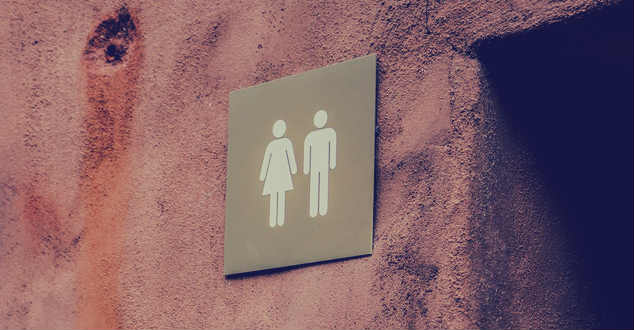
Diarrhea is another very common side effect of a keto diet.
Check out the full guide with other possible remedies for keto diarrhea and more detailed tips.
Constipation
Some people starting a keto diet don’t have problems with digesting fat but instead they suffer from constipation. You may get constipated on a ketogenic diet because you eat too little fiber or you lack some electrolytes.
This is not a very severe condition unless it lasts many days in a row and your system isn’t able to get rid of toxins and waste. In the case of the keto constipation, there are three major recommendations:
- Add fiber to your diet and increase the amount of keto-compliant vegetables at least two times (aim at 5-6 cups of vegetables a day). Make sure to eat a bigger portion of vegetables with your breakfast.
- Drink a lot of water (at least 2 litres per day).
- Make sure you aren’t deficient in magnesium, potassium or sodium.
- If the above doesn’t help, take a herbal laxative once or twice so that you eliminate all the waste from your colon.

Many people get constipated on a keto diet, so don’t worry too much about it.
Check out the full guide with other possible remedies for keto constipation.
Keto Breath
Once you get into ketosis and become a real fat-burning machine, your body will be extracting ketone bodies in many different ways. They will be flowing in you blood, your urine and even in your breath. This a little bit fruity breath of people in ketosis is called the keto breath.
Do you remember the three different types of ketones we’ve been talking about? For the reminder, they are acetone, acetoacetic acid and beta-hydroxyburytic acid. What causes the keto breath is acetone that’s simply being extracted through your breath.
In most cases this is not a very serious problem and it goes away after your body becomes fully keto-adapted, so be patient and don’t worry.
Read the full guide on the keto breath and discover more tips (as well as possible remedies).
Headaches
The keto headache is probably the most popular ketosis side effect almost every carb addict experiences. Fortunately, this is only temporary and usually lasts not more than a week. The keto headache is one of the main symptoms of the keto flu which usually starts on the first days of carb restriction.
Even though it disappears by itself in most cases, there a few things we can do to reduce it. The three top remedies include:
- Drinking a lot of water because the keto headache may be caused by mild dehydration.
- Supplementing potassium, magnesium and sodium. You can add a teaspoon of sodium to water and drink it.
- Drinking bone broth.

Headaches are a very common side effects of starting a keto diet.
Are you suffering from the keto headache? Read the full guide on the keto headache and learn about other possible remedies.
Rash
This is not a very common side effect of a ketogenic diet but some people experience the so-called keto rash once they stop eating carbs and enter ketosis. The keto rash (or simply itching) usually appears on your stomach, back, neck or chest on the left and right side of your body (symmetrically).
It isn’t really clear what causes the keto rash but there are a few theories trying to explain it. In most cases it is not a severe problem and it disappears by itself after you become fully keto-adapted. However, if it doesn’t disappear, there are at least a few things you might want to try (check the full guide below to learn more).

Rash may happen sometimes on a keto diet but it usually goes away on its own.
Read the full guide if you want to learn more about the keto rash, its possible causes and how you can cure it.
Other Ketosis Side Effects (Rare Cases)
These are the main side effects of ketosis and most people experience them only in their induction period. For others some side-effects may last longer and make it difficult to stick to a ketogenic diet for longer periods of time. These are very rare cases but they do happen.
Are you experiencing the side effect that’s not listed above? Check the full list of the keto diet side effects with possible remedies. Here is also a very cool guide describing different possible keto diet side effects.
Risks Of Keto Diet/Ketosis (Make Sure To Read This)
A ketogenic diet is probably one of the healthiest eating styles that promote well-being and longevity. Nevertheless, in some rare cases going on a keto diet may not be the best idea or may even be harmful.

Even though a keto diet is great and healthy, it may be risky for some people.
These are the possible scenarios where a keto diet may not be recommended and may involve risk:
- Type 1 diabetes
- Being underweight
- Problems with blood pressure
If any of the above applies to you, make sure to consult your physician before going on a keto diet.
Keto Diet Rules… Your Dietary Commandments From Now On
A keto diet is a bit strict but its rules are very simple and easy to understand. Once you get used to this eating plan, things will only become easier and easier. You will see.
Macros On A Keto Diet (The Upside-Down Version Of Standard Recommendations)
One of the biggest advantages of a ketogenic diet is that you don’t have to obsessively count calories and macros. All you need to do to induce ketosis is restrict carbohydrates (under 20 g a day), eat a moderate amount of protein (adjusted to your individual needs) and make sure to get the rest of your calories from fat.

The division of macronutrients in a keto diet is very favorable and appetite suppressing.
If significant weight loss isn’t your main goal, you don’t have to count calories at all. It’s only carbs that you need to count and watch. Once you get used to a keto diet, you will instantly know how many net carbs a given product has and how much of it you can have. This will become easy and almost automatic.
What’s more, remember that in most cases it’s enough to stick to a few general recommendations and you will be hitting your optimal macros (and achieving your health, fitness and weight loss goals).
The ranges for ideal keto macros are something like:
- 5-10% of calories from carbohydrates
- 15-25% of calories from protein (athletes should have a bit more protein)
- 65-80% of calories from fat (people wanting to lose weight can have less fat)
There are tons of keto macro calculators that will let you calculate your caloric and macro-nutrient needs. However, we don’t want to overcomplicate things here, so the most important pieces of advice on keto macros for you are:
- Only count carbs and make sure to stay below 20 grams per day (athletes can usually have a bit more and still stay in ketosis).
- Don’t overdo protein but make sure to eat 2-3 portions (20-30 grams per portion) of them every day.
- Don’t be afraid of fat and add it to your every meal and coffee. If you want to lose weight, eat less fat (so that more of it comes from your belly)
- If you are an athlete and you work out several times a week, you may want to slightly increase your protein intake (to 20-25% of daily calories).
Want to learn more about macros on keto? Check the full guide to keto macros and calculate the best macros for you. Here is a nice keto macro calculator I’ve been using a lot.
Do Calories Matter On Keto? Yes, They Do But…
You probably heard many people say that you can eat tons of fat on a ketogenic diet without counting calories and still lose weight. Others stubbornly believe in the “calories-in-calories-out” model claiming that any excess calories will ultimately turn into fat.

You cannot completely forget about calories on a keto diet.
The truth as always is in the middle. Here are the three things you need to remember regarding calories on a keto diet:
- A ketogenic diet is much more forgiving if you go overboard with calories in comparison to other diets (especially high-carb diets). Calories from fat are indeed differently metabolized than calories from carbs (which spike insulin, the fat-storing hormone). What’s more, fat is much more satiating. However, this does not mean that the sky is the limit for the daily calories on a keto diet. It is not.
- If your target is to lose weight, you may want to be careful with fat and not eat tons of it. Fat has 9 calories per gram, so calories may super quickly add up and you will find yourself eating 5000 kcal a day. If you need 2000 kcal per day and you eat 5000 kcal most of the days, you will indeed gain weight. I am sorry.
- If you are in ketosis, it’s best to use your own fat for energy instead of fat you eat. This way you will ensure the most optimal weight loss. To use your own fat, make sure you don’t go overboard with eating fat but rather focus on restricting carbs. 80-90% of calories coming from fat will not result in serious weight loss while 60-65% certainly will.
Check the full guide with more thoughts and tips on counting calories on a keto diet.
Foods To Eat On A Keto Diet (Take A Look At This Variety)
Here are the best food choices from the lowest (you can eat them freely) to the highest in carbs (you need to eat them in moderation or avoid completely).
The farther down the list you go, the more careful you need to be with the products. Under each list you can see the picture showing these foods and the amount of carbs per 100 g they contain. Bon appetit!
0-1 carbs per 100 g- Fats like butter, coconut oil, olive oil, MCT oil or mayonnaise
- Meat
- Eggs
- Fish and seafood
- Cheese
- Non-sweet drinks like water, tea or black coffee
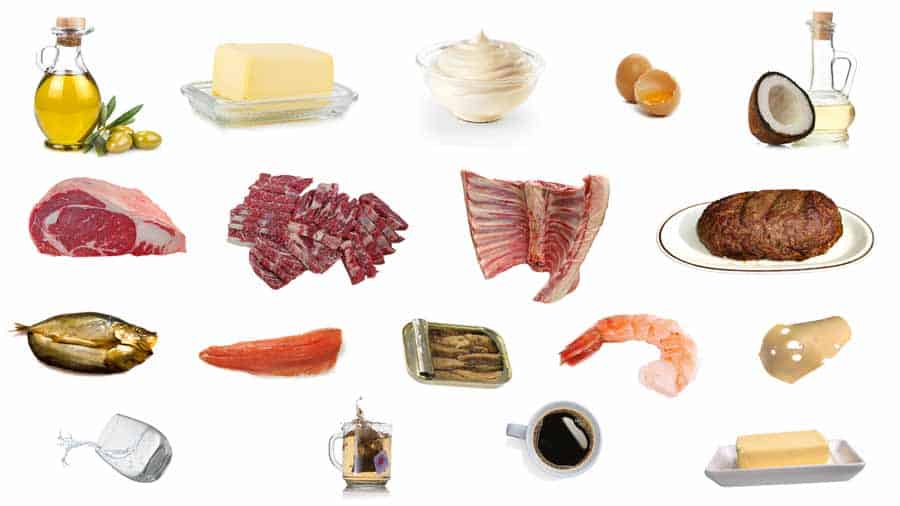
These are the examples of keto foods with 0-1 carbs per 100 g.
You don’t really need to worry about carbs when eating those foods. However, some of them contain a lot of fat and protein, so you need to be careful not to exceed your daily calories too much.
2-5 carbs per 100 g- Green vegetables like avocados, cucumber, broccoli, olives, kale, brussels sprouts, spinach, lettuce, asparagus, eggplant, green beans
- Other vegetables growing above the ground like tomato or pepper
- Heavy whipping cream, cream cheese, cottage cheese, milk
- Some nuts like macadamia, Brazil or pecan and some nut butters (with no added sugar)
- Some fruits like raspberry or blackberry
- Mushroom

The examples of keto foods that have 2-5 grams of net carbs.
You can eat as many leafy green vegetables as you feel like. They have carbs but they are also rich in fiber, so it’s really hard to eat tons of extra calories (or carbs) from them.
6- 10 carbs per 100 g- Some nuts like peanut, walnut, hazelnut, almond
- Vegetables growing below the ground like onion, carrot, turnips, beetroot or celeriac
- Some fruits like lemon, peach, plum, orange, watermelon or cherries
- Coconut and almond flour
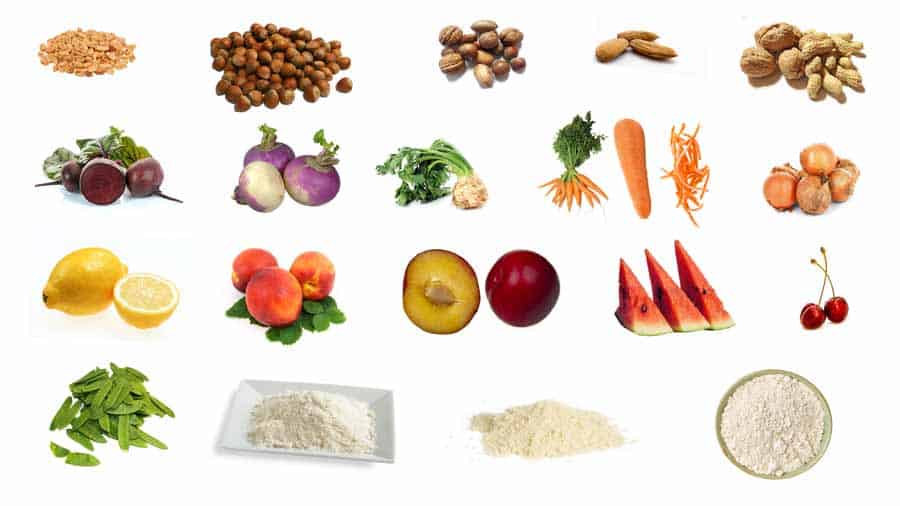
These keto foods have between 6-10 grams of net carbs.
These foods are great additions to your main meals. You can also use them as snacks but make sure to always count them against your daily carb number.
Above 10 carbs per 100 g- Fruits like banana, grape, mango, pineapple, cherries, clementines, apple, pear, kiwi, any candied fruit and dry fruits
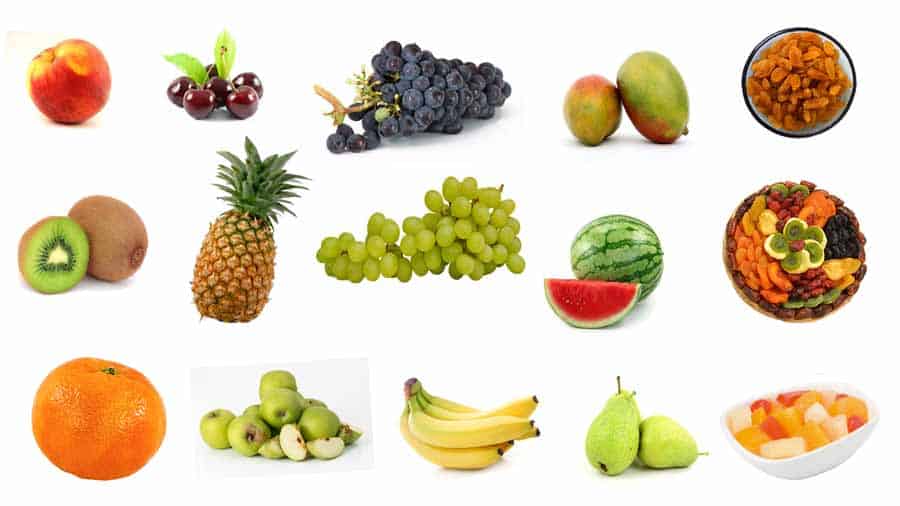
These are the fruits you either need to avoid or be very careful with on a keto diet.
Most keto diet guides don’t advise eating these foods. ABC Keto also doesn’t suggest making them part of your daily diet. However, nothing will happen if you eat their small portion on your carb-up day or before an intensive workout.
To learn all about what to eat on a keto diet, visit the keto foods section.
Foods To Avoid On A Keto Diet (Absolute No)
There are certain types of food that you should avoid on a keto diet at all costs. You guessed it. I am talking about foods high in carbohydrates (especially sugar and other refined carbs).
The main products you may want to avoid on a ketogenic diet include:
- Any type of sweets or products containing sugar
- Flour and any wheat-based products
- Pastas, rice, potatoes, bread
- Sweetened and artificially-sweetened drinks
- Fast foods
- Alcohol beverages high in sugar (especially beer, sweet wines and drinks)
- Most foods labelled as “fit”, “low-carb” or “zero” (they are usually the worst)
- Fruits very high in sugar (like bananas, grapes)

These are the foods to avoid on a keto diet.
Instead of eating products full of sugar, flour and trans fats, you can eat healthy and much more delicious keto alternatives made with coconut/almond flour and sweetened with Stevia/erythritol. Once you start eating such foods, you will never want to come back to the old way of eating. I swear.
Do you have some other foods in mind and are unsure if you can eat them? Read the full list of the ketogenic diet foods to avoid.
What Supplements To Take On A Keto Diet (Top Three Almost Everyone Has To Take)
Putting your body into the state of ketosis is a serious metabolic revolution for your system. Your body, which has probably been running on sugar your whole life, will now have to create new enzymes and learn how to use fat as an energy source.

You have to remember about these three supplements on a keto diet.
Even though foods on a ketogenic diet are highly nutritious and healthy, you might experience some deficiencies. The top three minerals you will probably need to supplement on a keto diet include:
When you eat carbs, you retain water in your body. When you go on a keto diet, most of this water goes away. That’s why many people lose several pounds of weight in the first weeks of a keto diet.
It’s especially important to take these supplements during the adaptation period. Taking any other supplements depends on your specific situation, history or simply “context” you are in.
Still not sure what to take? Check my review of the top keto diet supplements together with information and tips on taking them. Also check this article about using keto supplements.
How About Cheating On A Keto Diet? The Good & Bad News
If you like cheating, you cannot miss this section. Cheating doesn’t have to destroy your diet or nullify your progress. It’s ultimately within your control how to use this tool but you can actually use it to your benefit. You just need to know how.

It’s up to you how you use the cheating tool on a keto diet.
The many years of my rich experiences with different types of diets and possibilities of talking to lots of dietitians, personal trainers or doctors led me to the following observations and conclusions about cheat meals, cheat days and cheating (both on a keto diet and in general):
- Some people claim cheat meals are for losers and should be avoided at all costs (especially on strict eating plans like keto).
- Others stubbornly believe than everyone needs and deserves to a cheat meal or cheat day at least once in a while.
- Those who are against cheating sooner or later realize that it’s not possible not to cheat at all and move to the second group. They either entirely give up on dieting or work on adding a cheat day or cheat meal to their dieting schedule so that it actually helps them.
Having a cheat meal or a cheat day has both pros and cons. It can totally throw you out of ketosis and stop (or even reverse) your progress for many days. A cheat day can also give a nice boost to your metabolism and lower your cortisol levels (the stress hormone) if you’ve been on a caloric deficit for a long time.
As you can see, cheating can be both detrimental and beneficial to your keto diet. The great news is that it’s totally within your control how you use this tool.
Are you a cheater? Do you happen to cheat more often than others? Read the essential keto diet cheat day guide where I will tell you how to cheat to actually benefit from it.
Ketogenic Diet Mistakes… And How To Avoid Them
You’ve been doing a ketogenic diet for some time but you aren’t happy about the results. You’ve been doing everything by the book (or at least it seems so) but you are still not in ketosis. The chances are that you are committing one or more of the most common keto diet mistakes.

Make sure you are not committing any of the most popular keto mistakes.
Here is a quick review of the top keto diet mistakes everyone makes at the beginning of their keto journey:
- Exceeding the allowed 20-30 grams of net carbs a day. This, of course, almost always happens unintentionally and unconsciously. People usually exceed the allowed amount of carbs because of the so-called hidden carbs. And hidden carbs are usually in products we were sure were 100% keto-friendly (but we forgot to verify that). The takeaway for you is to ALWAYS read the label and count net carbs.
- Eating too much protein in relation to the amount of fat your are consuming. Any excess protein is ultimately converted to glucose and acts like carbs (through the process called gluconeogenesis (see the Wikipedia article for details). To be on the safe side, don’t eat more than 20% of your daily calories from protein. For example, if you eat 2000 kcal a day, the maximum safe amount of protein for you is 100 g.
- Eating too much protein in one meal. This is also a very common reason why people get kicked out of ketosis even though overall they don’t eat more than 20% of their daily calories from protein. The safest bet here is to eat not more than 30 g of protein at one meal and never eat lean protein. The ideal ratio would be 1:2, so for each 30 g of protein you consume 60 g of fat.
- Going overboard with dairy. One of the blessing of a keto diet is that it lets you consume dairy products which are forbidden on many other health-oriented programs. Dairy (especially low-fat) has lots of sugar (lactose, milk sugar, is simply glucose for our body) which can very quickly add up. One Caffee Latte (even unsweetened) will probably kick you out of ketosis. That’s why I recommend limiting dairy and using only the full-fat options like heavy whipping cream.
These are the top 3 mistakes everyone makes on their keto journey. Watch out for them so that you can reach your goals more quickly.
Want to make sure you are in the clear? Check the full list of the most common keto diet mistakes and quick fixes.
Why Am I Not In Ketosis? Possible Reasons & Quick Fixes
In most cases you are not in ketosis because you are making one of the most common and most obvious mistakes listed above. However, sometimes the problem is a bit more complex and you need to do further “investigation” to find out why you cannot enter ketosis.

Sometimes you need to do thorough investigation to learn why you cannot enter ketosis.
My so-far experience shows that even some of the following factors may stop your from entering ketosis: stress (including high levels of cortisol), eating too many calories overall, lack of sleep, electrolyte and mineral deficiency, some drugs and more.
Not making any of the serious keto mistakes but still not in ketosis? Check the full article and learn about other reasons why you are not in ketosis (and how you can try to fix it).
Example Keto Meals… To Make Your Mouth Water
This section is more about the theory of a ketogenic diet so that you can better understand how it works and what it really does to you body. However, you can achieve ketosis only if you eat certain foods in a certain way. Here is a quick wrap-up of what will be eating on a keto diet.
Breakfast (That Is The Best On Earth)
On a ketogenic diet you will be eating really delicious and satiating meals for breakfast. Many keto breakfast dishes are also very easy to prepare. You can have them ready usually within minutes.
If you are just starting a ketogenic diet, this is how the most legendary keto breakfast (eggs and bacon) looks like.

This keto breakfast looks yummy, doesn’t it?
Check the best keto breakfast recipes in the world or discover the guide to preparing the perfect keto breakfast.
Lunch (After Which You Never Crash)
Who said that preparing a keto lunch should be complicated and time-consuming? No one! You can eat incredibly tasty and satiating meals for lunch as well.
All you need to remember when preparing a keto lunch is to add vegetables, a moderate portion of protein (about 20-30 grams) and a lot of fat. This is how your keto lunch may look like.

Wouldn’t you eat this keto lunch? I would die for it!
Check the best keto lunch recipes in the world or discover the guide to preparing the perfect keto lunch.
Dinner (That Actually Makes You Feel Satisfied And Full)
If you ate a lot of fresh vegetables for your keto breakfast, you can eat either pickled, cooked or fried vegetables for your keto dinner.
The rule of thumb when preparing your keto dinner remains the same: you need a moderate amount of protein, a decent amount of fat and some carbs coming mostly from veggies or nuts. Take a look at this delicious keto dinner.

How about this keto dinner? It’s just as tasty as other keto meals.
Check the best keto dinner recipes in the world or learn how to prepare the perfect keto dinner.
Coffee (That Suppresses Your Appetite And Makes You Burn Fat)
If you are a coffee addict just like me, I have some great news for you. You can still enjoy your coffee on a ketogenic diet or even make it more tasty.
Here are the main rules regarding coffee on a ketogenic diet:
- Do not put sugar into it or artificial sweeteners like aspartame
- Small amounts of natural sweeteners like stevia or erythritol are OK
- Be careful with adding milk which has almost 5 grams of carbs per 100g (coconut milk is way better)
- Feel free to add butter, coconut oil or heavy whipping cream
- Add cinnamon or cacao powder for better taste
Learn all about the keto coffe and how to prepare it and check out the full guide to making the best keto coffee in the world. Take a look at keto coffee recipes as well.
Keto Diet Research & Resources… To Prove That Keto Works Wonders
I am doing my best to stay up to date with what’s going on in the world of a ketogenic diet and current research on this eating lifestyle. Every day new research results appear and shed light on great properties of a keto diet.
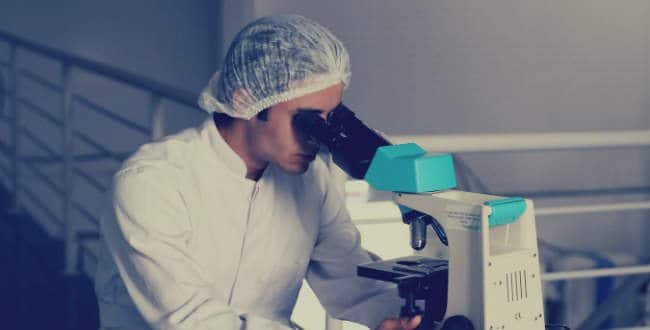
More and more research on a keto diet comes to light every day.
Below you will find the most important research findings that you simply need to know about and be aware of.
Health Benefits Of Ketogenic Diet And Ketosis
It’s really hard to list all of the possible health benefits of a ketogenic diet. Every day I discover new studies presenting new evidence and new examples of positive effects of a keto diet on health.
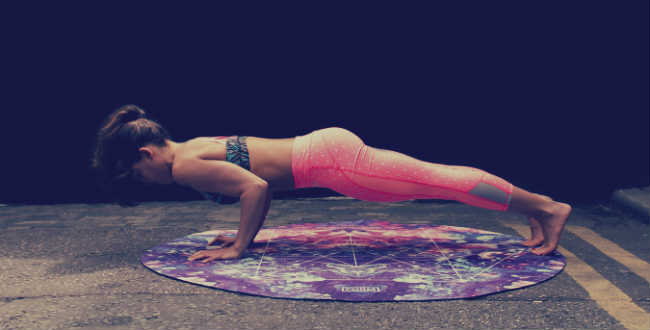
More and more research proves many health benefits of a keto diet.
The best-known health benefits of this eating plan (and low-carb plans in general) include control of type 2 diabetes, lowering the risk of heart disease, healthy and long-term weight loss, treatment of epilepsy, treatment of Alzheimer’s and Parkinson’s disease, regulation of blood pressure and… many others.
Discover even more health benefits of a ketogenic diet in my special guide with the discussion and links to specific research papers.
Epilepsy
A keto diet has been used to treat epilepsy in children since 1921. It turns out to be much more effective than most medications.

A keto diet is a known cure for epilepsy among children.
About 16% of patients are completely seizure-free after doing a ketogenic diet while in 56% the number of seizures usually drops by half. Note that we are talking about children who do not respond to medications at all.
Learn more about the ketogenic diet and epilepsy here (and discover links to specific research papers).
Cancer
Even though the research on a ketogenic diet and cancer isn’t very wide, there are more and more studies showing that a ketogenic diet can cure some forms of cancer and help prevent it.

If you want to starve a cancer cell to death, do not feed it with glucose.
It’s a known fact that cancer sells eat and grow on glucose. By eating a keto diet, we are literally starving cancer cells to death. How cool is that?
Check the current research findings on the ketogenic diet and cancer (and discover links to research papers).
Diabetes
If you suffer from type-2 diabetes, you can very quickly get rid of it thanks to a keto diet. You don’t need to take insulin or other medications and slowly watch your health deteriorate.

You don’t need to take any medications to cure type 2 diabetes. Just do a keto diet.
Almost everyone with the type-2 diabetes can get rid of it just within a few months of a keto diet and achieve a bunch of other health benefits as well. Why not take advantage of it?
Check the research findings on the ketogenic diet and diabetes.
Review Of The Most Important Ketogenic Diet Research Articles
There are a few especially outstanding research papers and studies proving the wonderful benefits of a keto diet. Many people won’t give a keto diet a chance unless they read through these studies.

Check out my review of the most important and interesting articles on a ketogenic diet.
If you are pressed for time, you don’t have to read these papers from cover to cover. I’ve done this for you and prepared the review presenting the most important papers, their findings and takeaways for you.
Check the review of the most interesting ketogenic diet research articles.
Common Sense On A Ketogenic Diet (Take It Easy & Relax)
A ketogenic diet (especially when combined with intermittent fasting) may be a really powerful tool that will let you achieve all your sports, endurance, weight loss and body composition goals.
However, just like any serious change in your life, diet or training routine, it puts an enormous amount of stress on your system. A body that is highly stressed out won’t cooperate well and will be prone to injuries, diseases and other negative effects.
That’s why the golden rule for any ketogenic diet newbie is to avoid extremities and apply common sense wherever possible. You don’t need to lose 30 kilograms in one month. You don’t have to work out 7 times a week to increase your weight loss rate. You don’t have to restrict your calories and starve yourself. You can chill out and still succeed.

Common sense on a keto diet is important. Relax and take it easy.
All you need to do is TRUST THE PROCESS because it works and is enjoyable. Welcome to ABC Keto.
More Keto Diet Resources (Don’t Miss This)
Knowledge is power and key to your success. Take a look at other in-depth keto diet tutorials available here on ABC Keto.
- Keto Foods to know what to eat and discover the most delicious foods in the world
- Keto Recipes to start cooking the healthiest and the tastiest meals on earth
- Keto Diet And Weight Loss to get inspired and effortlessly lose weight
- Intermittent Fasting to discover a secret weight loss and health tool our ancestors used
Help ABC Keto Improve
Do you want me to add more information about a specific keto diet aspect? Have you noticed a mistake on this web page? Is some part of this section not entirely clear? Let me know!
This section (as well as the whole ABC Keto) has been created for you and its purpose is to serve you. That’s why I want you to help me make it as cool as possible.
Feel free to leave your suggestions. You can either leave me your comments or contact me directly. I would love to hear from you.



